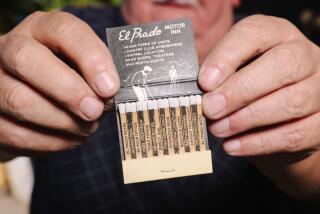Newcomer Can Learn Fast From a Club
- Share via
We receive a number of questions on what is the best way to become knowledgeable in one collectible field or another. One of the most efficient methods of quickly soaking up information is to join a collectors’ club.
Whether you are interested in learning about collecting bottles or political buttons, there are a number of benefits in taking this route. For openers, you’ll meet other people of similar interests, some of whom may be experts in the field of your choice.
And, just as important, you’ll undoubtedly learn about your field’s pitfalls--such as counterfeit collectibles.
Libraries and bookstores abound with volumes on collectibles; and, invariably, under each category or in the index are lists of collectors’ clubs. From time to time, we list such organizations in these columns, as we did recently with several post card-collector clubs.
Trade shows also provide an opportunity to meet people active in these clubs and to accumulate information on your collectible field.
If you feel that there is a void in your chosen specialty, you should write national or international chapters of a club, and inquire into establishing a local chapter.
Another advantage of a club is that it will put you in touch with publications in your chosen field. And, many clubs have newsletters, which can become a valuable resource in both learning about your field and meeting other collectors.
Question: I have an ice cream scoop with a wooden handle. It appears to be quite old, and I wondered when scoops began being used in ice cream shops.--K.F.
Answer: Items associated with the ice cream industry began appearing in this country after the Civil War. Because scoops are among the earliest of these highly collectible items, it’s possible that your scoop is quite old.
Dealer prices on scoops in good condition have ranged up to $200; more typically, however, prices of $100 or less are more common. Scoops with such price tags generally have wooden handles, and the metal part is free of rust and/or dents.
Dating your scoop with any precision would be difficult, however, if there is no manufacturer or other identifying mark on it.
More broadly, ice cream collectibles fall into a definite nostalgia category and have been popular for years. Signs, buttons and trays all fall into this collectible category and, in good condition, fetch pretty good prices.
Old ice cream trays, for example, with signs depicting a particular period, can bring as much as $200 or more.
After World War I, ice cream producers began issuing premiums with their products, such as trading cards and buttons, and these are very popular among collectors too.
Q: Dunhill pipes have always been highly collectible. I have a number in my pipe collection. When were they first available on the market?--J.D.
A: Alfred Dunhill, the prestigious English pipe producer, first opened a shop in 1907 but didn’t make a pipe until three years later.
Pipe collectors tell us that Dunhill pipes are numbered so that collectors can tell when the pipe was manufactured. More complicated is the manufacturer’s lettering system for some of its pipes, which gives collectors a measure of the quality of the pipe’s grain.
Dunhill has produced several collectible pipe categories over the years, some of them fairly expensive, so the collector will have to do some homework to stay current.
A pipe collectors’ club in the United States with some following is Pipe Collectors International, P.O. Box 22085, 6172 Airways Blvd., Chattanooga, Tenn. 37422.
Ronald L. Soble cannot answer mail personally but will respond in this column to questions of general interest about collectibles. Do not telephone. Write to Your Collectibles, You section, The Times, Times Mirror Square, Los Angeles 90053.


